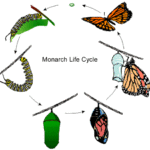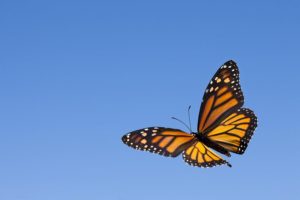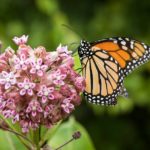- Life Cycle
- Population
- Wing Pattern and Coloration
- Location
- Diet
- Defenses
- Pollinators
Life Cycle
Monarch butterflies have four phases in their life cycle. The first is the egg phase. Monarchs fly north in the spring to find a suitable place to lay their eggs. Females can lay 300 to 500 eggs over two to five weeks. Monarchs usually lay their eggs on the underside of milkweed plants, as this is the caterpillar’s first choice of food. Hatching usually takes 3-5 days.
The second phase is the larval stage, commonly known as the caterpillar. The caterpillar’s goal is to eat as much as it can so it will grow and then molt its skin when it becomes too large. There are about 5 molting stages, and each can last from 1-3 days.
Next is the pupal phase or chrysalis. This is when the caterpillar spins silk and creates a hard shell to protect itself from the environment while its vulnerably transitioning into a butterfly. Once the monarch butterfly exits its chrysalis, its primary purpose is to reproduce and start the next generation of monarchs. Reproduction can start when the butterfly is only 3 – 8 days old. Many monarchs will live to about 8 months as well as migrate during the cold months.
Population
Monarch population has declined about 80% in just the past 20years. This is primarily because they have lost 165 acres of breeding grounds due to spraying and development. The current population is estimated to be around 150 million, which may seem bountiful, but in 1997 the population was estimated at 682 million monarch butterflies.
Wing Pattern and Coloration
Their orange wing pattern is quite bold and easy to spot. The bright orange coloration actually benefits them greatly as it deters predators. It acts as sort of a warning to creatures looking to harm them. Their intricate wing pattern also is a great method of distincting the Monarch Butterfly from it’s common mistaken relative, the Viceroy or Limenitis archippus. The variation in wing size is also a great distinguisher. A fun fact is that there is actually a white monarch spotted and bred in Oahu, HI. These rare beauties are a site to see.

Location
Overwintering butterflies can be found in Mexico, but as the temperature rises in the spring, the monarchs begin to fly north. Most of the monarch population lives west of the Rocky Mountains but you can still expect to see some traveling all the way to Canada in the summer. Some monarchs have been spotted in Hawaii primarily due to the fact that they lost their way while flying from California to Mexico. They have successfully colonized in Hawaii.
Diet
Monarch caterpillars primarily eat milkweed. Milkweed secretes a toxin that the caterpillar ingests, making them poisonous to their predators throughout their life. The adult Monarch butterflies usually feed on nectar of several plants including their beloved milkweed.
caterpillar ingests, making them poisonous to their predators throughout their life. The adult Monarch butterflies usually feed on nectar of several plants including their beloved milkweed.
Defenses
Monarch butterflies first eat their eggs as a larvae and then move on to the milkweed upon which they were laid. This plant typically is not toxic enough to the monarch unless it is affected by carbon dioxide levels. The milkweed does not leave the gut of the larvae even after they become butterflies. It causes a cardiac poison that kills in most vertebrates. Their coloring of bright orange is a warning to predators that they are poisonous. These two methods are their very strong defense system.
About Pollinators
Pollinators are animals that move from plant to plant while searching for protein-rich pollen or high-energy nectar to eat. As they go, they are dusted by pollen and move it to the next flower, fertilizing the plant and allowing it to reproduce and form seeds, berries, fruits and other plant foods that form the foundation of the food chain for other species—including humans. Pollinators are themselves important food sources for other wildlife. Countless birds, mammals, reptiles, and amphibians eat the protein and fat-rich eggs, larvae, or adult forms of pollinators, or feed them to their young. Pollinators play a critical role in the food supply for wildlife and people!
Bees are well-known pollinators, but over 100,000 invertebrates—including butterflies (Monarchs specifically), moths, wasps, flies, and beetles—and over 1,000 mammals, birds, reptiles and amphibians, act as pollinators.
Monarchs as Pollinators

The monarch population has declined by more than 90 percent since the 1990s. The monarch butterfly faces several risks. Climate change alters the timing of migration and rainfall patterns in their forest habitat. They’re also facing forest fragmentation and habitat loss in the United States and Mexico. In addition, pesticides kill milkweed, which the monarchs rely on for survival. The U.S. Fish & Wildlife Service is currently reviewing their status.

Although the Monarch population is in decline, there are ways we can help the species. Creating a habitat by planting milkweed or nectar plants is one easy way to help the monarch. North America has several dozen native species of milkweed, with at least one species naturally found in any given area. Planting a local species is the best option for helping monarchs is a particular area.
Providing a Pollinator Friendly Backyard
|
Food
Places to Raise Young
Sustain Healthy Pollinator Habitat
Providing Clean Water
|
Resources
People’s Testimony
https://journeynorth.org/tm/monarch/ConservationValuesBrowerQA.html
Wing Pattern and Coloration
https://www.ncbi.nlm.nih.gov/pmc/articles/PMC4512236/#R17
Monarchs as Pollinators
https://monarchjointventure.org/resources/faq/why-is-the-monarch-population-decline-important
https://ento.psu.edu/pollinators/resources-and-outreach/what-are-pollinators-and-why-do-we-need-them
Monarchs and National Parks
https://www.nps.gov/articles/monarch-butterfly.htm